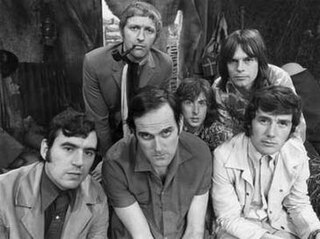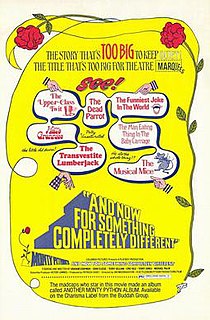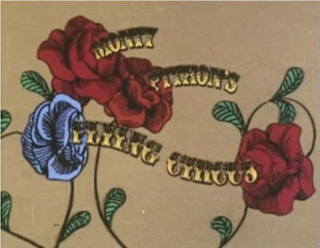Related Research Articles

Monty Python's Life of Brian, also known as Life of Brian, is a 1979 British comedy film starring and written by the comedy group Monty Python. It was directed by Jones. The film tells the story of Brian Cohen, a young Jewish-Roman man who is born on the same day as—and next door to—Jesus, and is subsequently mistaken for the Messiah.

Monty Python were a British surreal comedy troupe who created the sketch comedy television show Monty Python's Flying Circus, which first aired on the BBC in 1969. Forty-five episodes were made over four series. The Python phenomenon developed from the television series into something larger in scope and influence, including touring stage shows, films, albums, books and musicals. The Pythons' influence on comedy has been compared to the Beatles' influence on music. Regarded as an enduring icon of 1970s pop culture, their sketch show has been referred to as being "an important moment in the evolution of television comedy".

The "Dead Parrot Sketch", alternatively and originally known as the "Pet Shop Sketch" or "Parrot Sketch", is a sketch from Monty Python's Flying Circus about a non-existent species of parrot, called a "Norwegian Blue". A satire on poor customer service, it was written by John Cleese and Graham Chapman and initially performed in the show's first series, in the eighth episode.

The Cheese Shop is a well-known sketch from Monty Python's Flying Circus.

Monty Python's The Meaning of Life, also known simply as The Meaning of Life, is a 1983 British musical sketch comedy film written and performed by the Monty Python troupe, directed by Terry Jones. The Meaning of Life was the last feature film to star all six Python members before the death of Graham Chapman in 1989.

"The Ministry of Silly Walks" is a sketch from the Monty Python comedy troupe's television show Monty Python's Flying Circus, series 2, episode 1, which is entitled "Face the Press". The episode first aired on 15 September 1970. A shortened version of the sketch was performed for Monty Python Live at the Hollywood Bowl.

Monty Python Live at the Hollywood Bowl is a 1982 British concert comedy film directed by Terry Hughes and starring the Monty Python comedy troupe as they perform many of their sketches at the Hollywood Bowl. The film also features Carol Cleveland in numerous supporting roles and Neil Innes performing songs. Also present for the shows and participating as an 'extra' was Python superfan Kim "Howard" Johnson.

And Now for Something Completely Different is a 1971 British sketch comedy film based on the television comedy series Monty Python's Flying Circus featuring sketches from the show's first two series. The title was taken from a catchphrase used in the television show.
"Upper Class Twit of the Year" is a comedy sketch that was seen on the 1970 Monty Python's Flying Circus episode "The Naked Ant", and also in a modified format as the finale of the movie And Now for Something Completely Different. It is notable for its satire on dimwitted members of the English upper class. Its title is a reference to the Horse of the Year Show, because equestrianism is often regarded as an upper-class pursuit in the UK.

How to Irritate People is a US television broadcast filmed in the UK at LWT on 14 November 1968 and written by John Cleese, Graham Chapman, Marty Feldman and Tim Brooke-Taylor. Cleese, Chapman, and Brooke-Taylor also feature in it, along with future Monty Python collaborators Michael Palin and Connie Booth.

Mr. Creosote is a fictional character who appears in Monty Python's The Meaning of Life. He is a monstrously obese and rude restaurant patron who is served a vast amount of food and alcohol whilst vomiting repeatedly. After being persuaded to eat an after-dinner mint – "It's only wafer-thin" – he graphically explodes. The sequence opens the film's segment titled "Part VI: The Autumn Years".

"Argument Clinic" is a sketch from Monty Python's Flying Circus, written by John Cleese and Graham Chapman. The sketch was originally broadcast as part of the television series and has subsequently been performed live by the group. It relies heavily on wordplay and dialogue, and has been used as an example of how language works.

Parrot Sketch Not Included – 20 Years of Monty Python is a British television special to Monty Python, put together to celebrate the 20th anniversary of the debut of the comedy group's television series, Monty Python's Flying Circus. Produced by Tiger Aspect Productions for the BBC, it was compiled by noted British comedy producer John Lloyd and broadcast on BBC 1 on 18 November 1989.
"Dirty Hungarian Phrasebook" is a Monty Python sketch. It first aired in 1970 on Monty Python's Flying Circus as part of Episode 25. Atlas Obscura has noted that it may have been inspired by English as She Is Spoke, a 19th-century Portuguese–English phrase book regarded as a classic source of unintentional humour, as the given English translations are generally completely incoherent.

Python Night was an evening of Monty Python-related programmes broadcast on BBC2 on 9 October 1999, to celebrate the 30th anniversary of the first broadcast of Monty Python's Flying Circus. It featured newly written sketches, three documentaries and a screening of Monty Python's Life of Brian.
The "Architects Sketch" is a Monty Python sketch, first seen in episode 17 of Monty Python's Flying Circus, "The Buzz Aldrin Show". The episode was recorded on 18 September 1970 and originally broadcast on 20 October 1970. The following year, an audio version was recorded for Another Monty Python Record.
"Live from the Grill-O-Mat" is the fifth episode of Series 2 of Monty Python's Flying Circus. This show aired 27 October 1970 and was recorded 10 September 1970. The episode featured sketches including "Blackmail", "Society for Putting Things on Top of Other Things", "Accidents Sketch " and "The Butcher Who is Alternately Rude and Polite".

Monty Python's Flying Circus is a British surreal sketch comedy series created by and starring Graham Chapman, John Cleese, Eric Idle, Terry Jones, Michael Palin and Terry Gilliam, who became known as "Monty Python", or the "Pythons". The first episode was recorded at the BBC on 7 September 1969 and premiered on 5 October on BBC1, with 45 episodes airing over four series from 1969 to 1974, plus two episodes for German TV.
"Archaeology Today", recorded on 9 October 1970 and broadcast on 17 November 1970, was the 21st episode of the popular British television comedy Monty Python's Flying Circus which was created by the Monty Python group. As stated on the Monty Python's Flying Circus Wiki, "The show often targets the idiosyncrasies of British life, especially that of professionals, and is at times politically charged"; this episode in particular seems to target the professional world of anthropology and archaeology.
References
- ↑ Shell, Hanna Rose (2012). Hide and Seek: Camouflage, Photography, and the Media of Reconnaissance. New York: Zone Books. p. 127. ISBN 978-1-935408-22-2. LCCN 2011037201. OCLC 754613287.
- ↑ Handlen, Zack (15 August 2013). "Monty Python's Flying Circus: "How Not To Be Seen"/"Spam"". The A.V. Club . Retrieved 21 January 2021.
- ↑ Shell, Hanna Rose. Hide and Seek . p. 167.
- ↑ Lissoni, Andrea (January 2015). "'How Not to Be Seen: A Fucking Didactic Educational .MOV File', Hito Steyerl, 2013". Tate . Retrieved 21 January 2021.